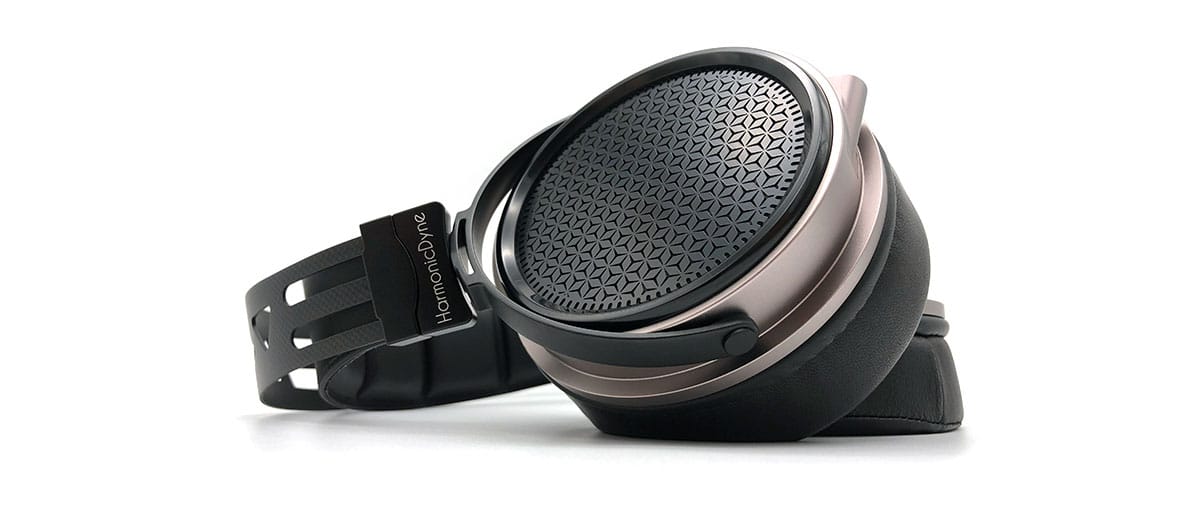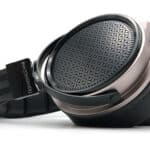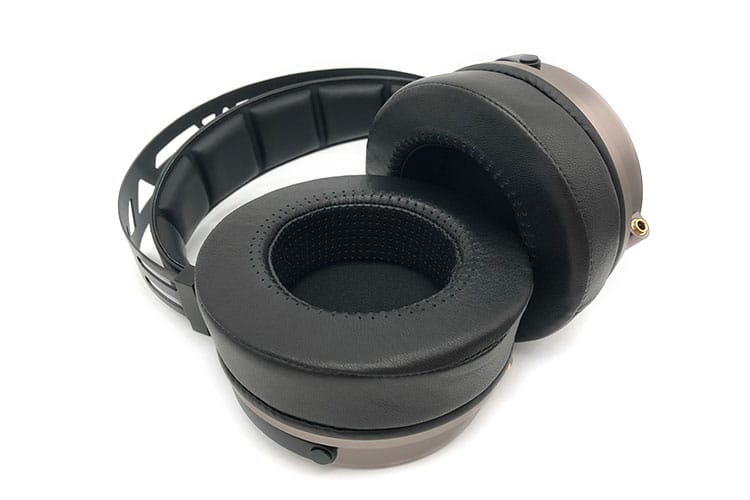In today’s feature, we review the HarmonicDyne G200 which is a set of new customized 102mm planar magnetic driver open-back headphones. It is priced at $699.
Disclaimer: This is a sample in exchange for our honest opinion. Headfonics is an independent website that does not have any affiliate links or status. We thank Linsoul for this opportunity.
To read more about HarmonicDyne products we have previously covered on Headfonics please click here.
Note, that this article follows our latest scoring guidelines which you can read up on here.
All of HarmonicDyne’s headphones to date are open-back dynamic driver headphones such as the Zeus and Poseidon. Each with a different diaphragm coating to satisfy different tastes and budgets.
It’s already been a year since the company released the Poseidon as their TOTL model sporting nickel-plated drivers after being on Kickstarter for a while. I haven’t heard of the G200 being on Kickstarter meaning that HarmonicDyne is doing well and has grown enough to launch a product on its own.
Replacing the Poseidon as the flagship, the G200 has big shoes to fill. Not just because it is venturing into new territory with its planar drivers, but it will also set the stage for HarmonicDyne in terms of higher-end offerings.
Tech Highlights
This is the company’s first-ever set of open-back planar magnetic driver headphones having focused primarily on dynamic driver designs before.
The G200 comes equipped with a custom 102mm nanocomposite planar diaphragm. The design is capable of pushing 10Hz up to 45kHz and has a measured efficiency of 64Ω impedance and 100dB sensitivity.
Unlike other planar headphones with very little known about their structure, HarmonicDyne is openly promoting the G200 as an advanced assembly utilizing an isokinetic magnetic field.
With a high-density S+1 coil and double-sided high-pass magnetic tapes, the THD is greatly reduced since the diaphragm vibrates evenly.
Design
With the Zeus, as much as it looked good, I still wondered why HarmonicDyne fit it with an intricate cup design that tends to catch skin when touched and a rickety headband mechanism. They did redesign the cups with the Poseidon solving my first complaint but kept the old headband.
For the G200, they’re leaving me in awe as the new design is totally fresh and very chic. Gone are the unwieldy vinyl wood-lined headband and intricate cup design making this their most modern-looking set yet.
The contrast of black and gray plus the materials and precision on the G200 give it a rock-solid look and feel. Aluminum alloy and carbon fiber are used for the cups and headband with a choice of lambskin or suede for the earpads.
Swapping pads is as easy as sliding the flaps underneath the ring guide around the cups of the G200. The whole process is easy and shouldn’t take longer than a minute.
Looking from afar, the G200 does look simple with its thin supporting frame and rounded ear cups. What sets it apart is the geometric cutout on the carbon fiber and the three-pointed star ladder pattern on the face of the cups.
Designed for comfort as well, the G200 makes use of a leather suspension strap affixed to the sliding mechanism for adjusting to the wearer’s head size. HarmonicDyne also angled the 3.5mm sockets to keep the cables from touching the shoulders and protecting them from accidental bumps.
Comfort
Striking a balance between comfort and tech, the G200 is using carbon fiber for its headband attributing most of its 480g weight to the planar drivers on the cups. Stretching the headband can feel a bit stiffer than usual as I find the carbon fiber increasing in pressure unlike the more linear increment on cans using conventional spring steel.
The suspension strap stuck on the adjustment mechanism has memory foam pads and is the one doing most of the heavy lifting when worn. What the thick earpads provide is for keeping the headphone stable when the cups start to move around when doing sudden head movements.
Between the two, I find the suede ones to be more comfortable. Not just because it has a memory-type foam filling but because it also presses more reassuringly on the head compared to the leather pads that don’t conform as much.
One final thing that I must say that needs careful consideration before buying is fit since both the leather and suede push unevenly on my temples leaving a gap below. Two things are contributing to this, one is the lack of jaw pressure and the pads being too thick in consideration of the headphone’s mechanism.
Stock Cable
The evolution of HarmonicDyne doesn’t seem to stop with their headphones as I find them also slowly improving their cables as they incorporate feedback from the community. Having owned the Zeus myself, I have a fair share of comments about the cable provided and I’m happy that none of those made it to the G200.
Just a bit longer than usual, the longer length of the cable measuring two meters greatly improves utility. This is a more usable length providing breathing room for movement while not being too long like the three-meter ones from Sennheiser.
The headphone connector is 3.5mm and terminates on the other end to a balanced four-pin XLR. I would prefer a 4.4mm termination to reduce weight and improve portability since the full-size XLR is bulky to lug around, more so when using the included adaptors.
What’s great however is that we at least get solid and good-quality connectors. The most common complaint from Poseidon is the cheap and clunky XLR sockets.
The mixed copper and silver-plated copper cable are the same for both the main cable and all of the adaptors. Besides, the thick and transparent four-weave cable is much softer and has little memory retention compared to the ones from Zeus.
Packaging & Accessories
HarmonicDyne sent the G200 over in a sizable cardboard box sandwiching the case containing the headphones and accessories with inch-thick foam. While honestly a bit excessive for a headphone, the G200 will surely arrive with no issues caused by mishandling.
Correct me if I’m wrong but I believe this is the first time HarmonicDyne is using the black storage case of the G200.
Unlike before, the case is more suited for displaying the unit for observation instead of protecting it during transport. Not only is the case missing a handle but also once you remove the thin foam on the underside of the top cover, the G200 will be in plain sight through the glass panel.
The G200 is laid flat with the ear cup vents facing upwards. What is preinstalled on the unit is the leather pads but additional suede pads have been included in the upper right corner.
What’s left for the unboxing is the paper works, microfiber cloth, serial number card, and cables stowed on the lower right. As mentioned in the stock cable section, HarmonicDyne doesn’t choose for you as they provide all the necessary adaptors for almost any source type.
Sound Impressions
Summary
With most headphones playing safe, you might be expecting a completely sterile to bright profile or a warm and V-shaped signature. Not with the G200. Honestly, before I began with the review of this set, I had to calm down my biases while I was still in the first few hours of listening.
First things first, I’m still using the leather pads of the G200 up to this point. The vocal region is heavily recessed and muffled so halfway through I had to switch to a different headphone to gain back clarity.
I’ll explain the sonic traits of the leather pads in detail in a succeeding section since I quickly discovered that the suede pads sounded more forward in the midrange even though still recessed. The suede pads are what I ended up using for the rest of the review.
The lower region isn’t boosted but lifted enough just to make the beats refreshingly audible. The highs, however, continue the lack of forwardness of the midrange, especially in the lower treble region but is surprisingly well-extended and slice through a scene when needed.
I wouldn’t say that the G200 isn’t resolving, not by a long stretch. If you focus on each element like in an etched bass guitar and cymbals crashing, sure it still wouldn’t compete with summit-fi headphones but against its peers, it can recreate a scene quite adeptly if only tuned a bit darker.
Timbre
The key component surrounding the G200 making it sound unique is pliability and weight. Anything it plays, it plays with a sense of unhurriedness that can lull to a restful trance.
Not overly sweet nor inviting, the softness of drums even with a rounded edge isn’t a mess. The bass of the G200 while slow sounding still carefully assembles into a thick and strong rumble.
What the G200 lacks in speed and punch holding back realism especially when beats start to overlap, it makes up for in other things. Push the planar drivers of the G200 with a clean bass guitar solo and it will return a pleasing sub-bass extension with improvement in the definition.
Carrying the hefty tonality through to the vocal section. The timbre and tonal balance give voices a sense of dreaminess as it fills up the lower midrange and pulls back on higher notes.
Having this type of sound profile though is taking away some of the clarity and air. Even the distinctive metallic twang of a guitar is hushed and turned into a gentle ring.
Similarly, cymbals don’t sound as steely as expected. The G200 though can impress with its top-end extension showing great care in sifting through a busy rock song, granted presence is still pulled back.
Where I enjoyed the sound of the G200 is with violins. Meaty and sweet, yet not as organic and vibrant as intended, the coloration makes the melody of the strings wash over with euphony and playful intensity.
Staging
Still, since the G200 has a darker tuning, mid-centric songs aren’t as holographic. With a bit of limitation in height and width, layering of a live audience clapping loudly is a bit compressed into a single dimension around the driver area.
Even though the G200 has an open-back design, it doesn’t get very spacious and dispersed when a song is asking for midrange clarity. On the other hand, once a brighter mix or instrument comes up, the stage opens up and increases the accuracy of imaging and directionality.
Finer instruments and effects can extend outside of the drivers once the treble extension kicks in. It allows for added air and space turning the staging area into an oblong shape.
Earpads
The lambskin pads are a bit darker and muffled sounding than the suedes, especially with female vocals where the latter provides greater balance when a singer plays around. I still love how the leather pads play well with deep male vocals for a fuller and thick timbre.
The instrument presentation is a mixed bag. Violins are darker and less organic, while electric guitars are slightly better etched and less busy.
Low-end performance is sacrificing a bit of texture as the bass draws up to be wider than the suedes. Still soft and unhurried, it is a matter of preference but I prefer the more collected drum hits found on the suedes.
The only reason I’ll go for the leather is the better separation between instruments I am getting in the same live audience setting the suedes struggled with. And the added forward stage if so desired.







